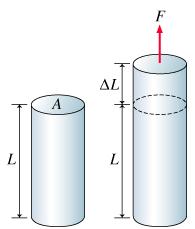Young's Modulus: Difference between revisions
Jlafiandra6 (talk | contribs) |
Jlafiandra6 (talk | contribs) |
||
| Line 71: | Line 71: | ||
===External links=== | ===External links=== | ||
[http://hyperphysics.phy-astr.gsu.edu/hbase/permot3.html] which is a great tool for just about any entry level physics. | HyperPhysics[http://hyperphysics.phy-astr.gsu.edu/hbase/permot3.html] which is a great tool for just about any entry level physics. | ||
==References== | ==References== | ||
Revision as of 23:43, 4 December 2015
This page discusses Young's Modulus and examples of how it is used.
Claimed by Jlafiandra6
The Main Idea
Young's Modulus is a macroscopic property of a material that measures how stretchy a solid material is. It is independent of size or weight, and it will change depending on the material.
A Mathematical Model
The definition of Young's Modulus can be expressed as: [math]\displaystyle{ {Y = \frac{stress}{strain}} = \frac{\frac{{F}_{T}}{A}}{\frac{{ΔL}}{L_o}} }[/math] where [math]\displaystyle{ {F}_{T} }[/math] is equal to the tension force, [math]\displaystyle{ A }[/math] is equal to the cross sectional area, [math]\displaystyle{ ΔL }[/math] is equal to the change in length due to the tension force, and [math]\displaystyle{ L_o }[/math] is equal to the initial length of the material.
A Computational Model
Examples
Be sure to show all steps in your solution and include diagrams whenever possible
Simple
A cylinder of wood has a stress of 800 and a strain of [math]\displaystyle{ 8*10^-7 }[/math]. What is Young's modulus for wood?
First we lay out the equation for the problem:
[math]\displaystyle{ {Y = \frac{stress}{strain}} }[/math]
We then plug in using the numbers given to us.
[math]\displaystyle{ {Y = \frac{800}{8*10^-7}} }[/math]
and so Y = 10^9 N/m^2
Middling
A flan created by Dr. Schatz has a strawberry placed on it, stretching the flan from a length of 0.15 m to 0.2 m. The flan has a cross sectional area of .01. With the knowledge that flan has a Young’s modulus of ~ 1.6e4 in tension, what force was used to stretch the flan?
First we would write out the equation for Youngs modulus: [math]\displaystyle{ {Y = \frac{stress}{strain}} = \frac{\frac{{F}_{T}}{A}}{\frac{{ΔL}}{L_o}} }[/math]
First we would write out the equation for Youngs modulus: [math]\displaystyle{ {1.6e4 = \frac{\frac{{F}_{T}}{.01}}{\frac{{.05}}{.15}}} }[/math]
We can then fill in every thing that we know: [math]\displaystyle{ {16000 = 300*F_T} }[/math]
And so,[math]\displaystyle{ {F_T} }[/math] is equal to 53.3!
Difficult
Connectedness
- Young's modulus is connected to all solid material, and it highlights the slight impression given to everything showing that things do push down ever so slightly on stuff that seems stationary.
- My major is CS, so not a ton in physics directly applies to it, but Young's modulus is guaranteed to be in every physics simulation built which attempts to simulate the building integrity and usage of materials.
- Young's modulus is used all the time in civil engineering and it is often used to help determine structural integrity of certain materials when deciding on a building.
History
Young's Modulus was first developed in 1727 by the famous Leonhard Euler in Switzerland, but it was further expanded upon by Italian scientist Giordano Riccati in 1782. Finally, it was given a name by the British Scientist Thomas Young who finished work on it in the 1800s. It is used in order to discover the elasticity of solid materials and shows the stress per strain of a solid material.
See also
Further reading
Books, Articles or other print media on this topic
External links
HyperPhysics[1] which is a great tool for just about any entry level physics.
References
Image: http://s3.amazonaws.com/answer-board-image/48bb8d83-d333-4467-bfc0-de7c7c6d1c12.jpeg History: https://en.wikipedia.org/wiki/Young%27s_modulus
